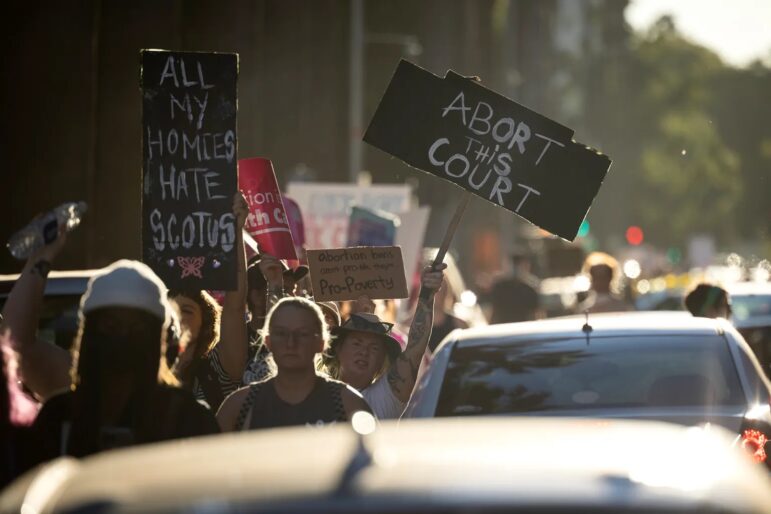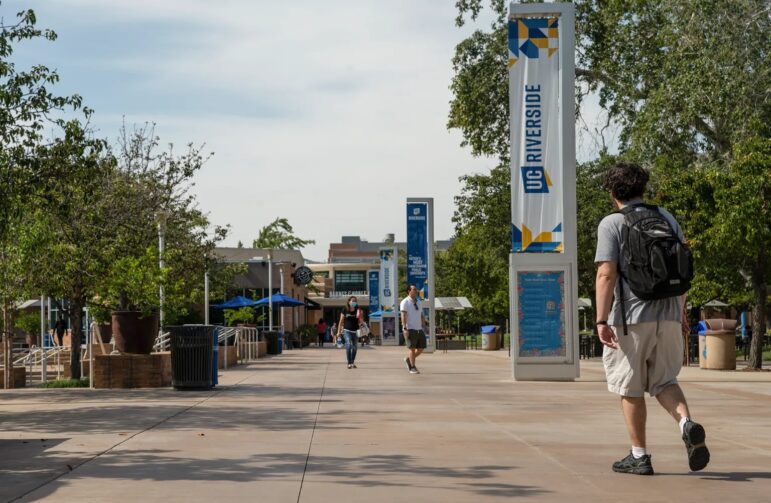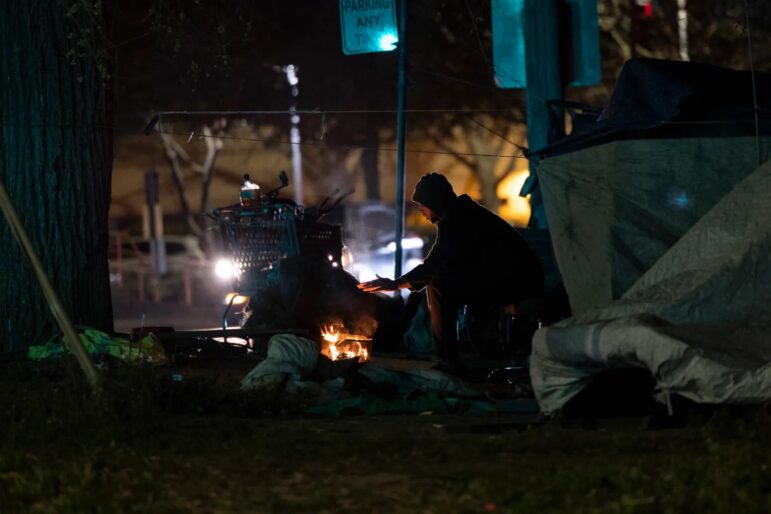California lawmakers are set to adopt a $300 billion budget this week that will provide refunds to most taxpayers in the state, pour resources into expanding abortion access and extend health care to more undocumented immigrants.
The state spending plan, which has grown to a record size as the economy recovered faster than anticipated from the coronavirus pandemic, is expected to be adopted before the start of the fiscal year on Friday, after Gov. Gavin Newsom and legislative leaders announced a deal on Sunday night.
Negotiations dragged on for several weeks as Newsom bargained with the Democratic leaders of the state Senate and Assembly over whether to tie the tax relief to car ownership; funding increases for universities, housing and social safety net programs; the details of a major climate package; and a plan that would give state regulators more control in approving clean energy projects.
The final agreement — which includes $234.4 billion in general fund spending and which legislative budget committees began debating today — is similar in many ways to a placeholder budget that the Legislature passed earlier this month to meet a constitutional deadline.
But at Newsom’s insistence, new spending commitments were slashed by several billion dollars and some appropriations will only be triggered in future years if revenue estimates hold up. As the state eyes another potential economic downturn, reserves will grow to nearly $38 billion, including more than $23 billion in the general rainy-day fund.
With tax revenues surging, driven by massive income gains among the wealthiest Californians, state leaders maneuvered to avoid the Gann Limit, an obscure provision that prohibits spending above a certain level per capita. Increased infrastructure and emergency expenditures, which are exempt in certain circumstances, as well as the tax refunds, will keep the state below the limit for the next few years. The Legislature is now considering placing a measure before voters on the 2024 ballot that would loosen the Gann Limit restrictions.
The tax rebate program, which has been publicly debated for months, is the centerpiece of the budget deal. Under the $9.5 billion plan, more than 95% of taxpayers — those making as much as $250,000 a year, or $500,000 if they file jointly — will receive a payment this fall. The amounts vary based on income and whether the recipients have dependents, so a low-income family with children will receive $1,050, while a single taxpayer with a higher income will receive just $200.
To reach Californians who do not file taxes, the state will also increase Supplemental Social Security grants by about $39 per month for individuals and $100 for couples, while welfare grants through CalWORKs will increase by an additional 10 percent for the next two years.
Here are other significant aspects of the budget deal:
Investing in abortion access
The state budget deal cemented Democrats’ commitment to supporting abortion access in California, investing $205 million to improve reproductive health care infrastructure and to ensure people seeking abortions can get to clinics.
The agreement earmarked $40 million in one-time funds to subsidize the cost of providing abortions to low-income or uninsured patients, including those who come from out of state. The deal also commits $20 million over three years to create the California Abortion Support Fund, which would hand out grants to women who need help paying for travel, lodging, child care and other expenses that advocates say prevent many low-income women from accessing abortion services.

More than $60 million will go towards shoring up the health care workforce by training more clinicians in abortion care and defraying higher education costs for future clinicians that commit to providing reproductive health services.
Other elements of the spending deal support a 15-bill package moving through the Legislature to expand abortion access. This includes one-time payments of $20 million for abortion clinics to improve physicial and digital security, $10 million for family planning services and $15 million for community-based organizations to improve sexual and reproductive health education. An additional $15 million in ongoing funds will go to Medi-Cal providers that perform abortions.
— Kristen Hwang
Extending the social safety net
The budget deal expands social spending, including by extending state health coverage to low-income undocumented immigrants of all ages and food assistance to immigrants ages 55 and older, who are currently excluded from the CalFresh program. The state would become the first in the nation to extend state food assistance to such immigrants.
Under the agreement, low-income Californians would also get a boost in cash aid through the CalWorks program and assistance in paying overdue utility bills incurred during the pandemic. Former foster youth would receive $1,000 a year through a new tax credit program.
The budget would put more than $260 million toward allowing single parents who get cash aid through CalWorks to also receive their child support checks, moving away from a long-standing state practice of keeping child support payments to reimburse itself for the welfare grants. The two-part plan would begin with families who are already off CalWORKS; starting in 2025, parents currently receiving cash aid would be allowed access to their full child support at the same time.
Lawmakers and the governor compromised on how far to go in reducing an obscure $300 late fee that courts often tack onto traffic tickets and other infractions. Civil rights advocates argue the practice can cause a simple fine to balloon as much as tenfold for poor defendants who cannot afford to pay the original ticket. Newsom’s administration remained opposed to a full elimination of the fine, which would have cost the state $100 million. Instead, under the deal the state would spend $10 million to forgive current debts and the fine would be reduced to a maximum of $100, which could prompt civil rights groups to renew a lawsuit they filed against the state court system challenging the practice.
— Jeanne Kuang
Boosting small businesses
Some relief is coming for small businesses. Under the new deal, the state will give $250 million to small businesses and nonprofits to offset the cost of offering up to two weeks of additional paid sick leave for COVID-19, a requirement added by the state in February.
More aid will be coming down the line. All employers will face tax increases starting in 2023 to pay back a massive loan the state received from the federal government to cover the surge of Californians claiming unemployment benefits early in the pandemic. That tax will increase by $21 per worker each year until the more than $17 billion loan is paid off. But the budget sets aside $500 million to help small businesses offset the higher taxes starting as soon as 2024, and directs $1 billion to paying down the loan principal this year.
The deal also allocates millions to upgrades at the embattled department that handles unemployment benefits. The Employment Development Department will receive, for example, $10.2 million to upgrade its cyber security, $21.5 million to support fraud investigation and prosecution efforts and $136 million for the first year of a multi year department-wide modernization project.
Tucked into a budget trailer bill is an attempt to attract jobs away from less progressive states. Starting in July 2023, decisions about which businesses receive a grant to add new jobs in California can factor in whether the company would be relocating jobs away from a state that limits access to abortion or “permits discrimination” on the basis of sexual orientation, gender identity, or gender expression. Newsom first teased that idea in a May speech, encouraging companies to come to the Golden State, where the “values that you express in your public documents are actually reflected in terms of the work we do as a state.”
— Grace Gedye
Another windfall for public schools
Following last year’s record-breaking education budget, public schools will receive yet another historic windfall. The final budget agreement increases the base funding for the local control funding formula, the mechanism through which most of the state’s public schools are funded, by $9 billion, or 13%. That means even more money for districts that serve high numbers of foster children, English learners and students from low-income households.
This is the largest single-year increase to the formula since its inception in 2013. The boost is a much-needed remedy for districts that have struggled to pay for ongoing costs such as salaries and benefits with one-time funding from the state and federal governments. However, in addition to the billions of dollars that schools have already received to navigate the pandemic’s aftermath, the budget includes another $8 billion in learning recovery grants that expire in five years.
This new money is paired with a measure that would help districts avoid a sudden drop in funding due to plummeting enrollment and attendance rates during the pandemic. State school funding is based on daily average attendance, but under the plan, school districts will have the option of using a three-year average or a pre-pandemic attendance rate applied to current enrollment. Public schools could have lost billions in funding without these alternatives.
The budget adds $4 billion in ongoing funding for before-school, after-school and summer school programs. With this appropriation, the state exceeds its $5 billion funding goal for these programs three years earlier than originally planned. The governor and legislators also agreed to expand eligibility and reduce class sizes for transitional kindergarten at a cost of $684 million.
But students can’t have longer school days and smaller class sizes without more teachers and aides. To help schools grapple with an ongoing staffing crisis, the budget allocates close to $2 billion in teacher preparation and retention efforts.
— Joe Hong
More student housing, but more aid?
The final budget deal promises billions of new dollars for colleges and universities, money that will largely go toward campus expansion projects and building more student housing. But it does not include funding increases for the University of California and California State University that the Legislature wanted beyond what Newsom proposed, and the fate of one key priority for lawmakers and student advocates is up in the air.
The multi-year effort to expand financial aid to older students will be funded if the state has money for it in the 2024-25 fiscal year. The plan in the budget deal is to add another 150,000 students to the Cal Grants program, which would cover the cost of tuition at public universities, partially cover tuition at private institutions and give more community college students living grants of about $1,650. About 500,000 students already get the Cal Grant. Expanding it would cost more than $300 million annually. While there’s no way to know if the state will have the money for this expansion in two years, the agency overseeing the Cal Grant is getting $500,000 to start implementing the changes.

Other financial aid is definitely coming. The state is adding more than half a billion dollars in grants for almost all UC and CSU students to advance a goal of “debt-free” college. And community college students who already get the Cal Grant and enroll full-time will get up to $8,000 in grants — doubling how much they could receive in past years.
The budget deal also sends $1.4 billion to the state’s public colleges and universities to build affordable student housing for this coming year, though that may only build space for about 6,000 more student beds given high construction costs despite a much greater need. The money is part of a four-year plan to ultimately spend $4 billion through grants and loans on student housing at the UC, CSU and community colleges.
— Mikhail Zinshteyn
Money for mental illness courts and homebuyers
Newsom’s ambitious and controversial plan to compel people living with severe mental illness into care through a new court system is still winding its way through the Legislature, and awaits further amendments, hearings and votes. But the budget already sets aside $39.5 million for this coming year and $37.7 million in ongoing annual funding to cover training, court costs and legal representation for the program, known as CARE Court.
The final deal also includes the biggest portion of the governor’s homelessness budget proposal: $1.5 billion over the next two years for interim housing for people who are homeless and experiencing serious mental illness. While the money could be used to build new treatment beds, it will mainly be used to fund existing spots that serve people with severe mental illness after they are discharged from an in-patient program. The administration plans to prioritize CARE Court participants, though many questions remain about how many beds the money would fund, in what types of facilities they would be and where they would be located.
Billions of dollars more will be directed towards cleaning up encampments and developing affordable housing.

To try to hold cities’ feet to the fire on housing production, a law that went into effect earlier this year shortened the timeline for cities with noncompliant housing element plans to complete their rezoning – a lengthy and convoluted process – from three years to one, or risk losing affordable housing funding. But language within the new budget package includes a carve-out for Los Angeles and other Southern California cities, once again giving them three years to rezone to accommodate more homes, as long as their plans are approved by the state.
The Legislature won a scaled-back version of its priority proposal to help first-time homebuyers with down payments, providing mortgage assistance in exchange for the state taking an ownership stake in the residence. Recouped costs and any profits from selling those houses would ultimately be funneled into a revolving fund to assist more homebuyers. The budget agreement includes $500 million to seed the program, half of what lawmakers had sought. An estimated 4,000 homebuyers could participate in the program in the first year, with additional allocations possible in future years.
— Manuela Tobias and Alejandro Lazo
Gas taxes and high-speed rail
Despite growing demands from Republican lawmakers, plus an increasing number of Democrats, the budget does not include a broad suspension of the state’s gas tax, which is set to increase by three cents on July 1. It will suspend a portion of the diesel sales tax, lowering prices by about 23 cents per gallon at a cost of $439 million and primarily benefiting businesses.
The governor finally got his way in a long-festering dispute with the Legislature over the future of California’s high-speed rail. Lawmakers refused to hand over the remaining $4.2 billion in bond funds for the project for more than a year as they sought to refocus construction in Southern California and the Bay Area. But under the budget agreement, the money will continue to prioritize the completion of the first rail segment between Merced and Bakersfield, while establishing an independent inspector general to oversee the project.
— Alexei Koseff
Fixing cannabis market
California will attempt to stabilize its nascent legal marijuana market by eliminating the cultivation tax, a major boon for small growers who have struggled to keep their farms going as the price for cannabis crops plummeted. In three years, the state could begin raising other cannabis taxes to make up for that lost revenue, which funds child care slots, environmental cleanup programs and impaired driving prevention efforts. The budget sets aside $150 million to backfill any shortfalls in the meantime. Recipients of social equity licenses, intended to diversify dispensary ownership, may be eligible to claim $10,000 tax credits for the next several years to help their businesses establish a foothold.
— Alexei Koseff
Preventing prison staff misconduct
More than a year after the Office of the Inspector General decried the state prison system’s employee disciplinary process as “broken,” Newsom and legislators committed more than $30 million each year for the next three years to overhaul the way prisons decide whether to sustain complaints against their staff.
The aim is to fix a system where 98% of prison employees are exonerated of misconduct charges by taking the disciplinary process out of the hands of people in the same prison as the accused and creating a centralized screening team to review complaints from prisoners, their families and others. The change is also intended to avoid retaliation by prison staff against inmates who file grievances.
This isn’t the first time the prison system has had to overhaul its complaint process. Just two years ago, the department replaced its old grievance system — and the dismissal rate of complaints actually increased.
— Nigel Duara
Health care access and affordability
The budget deal officially makes California the first state to expand health care access to all residents regardless of immigration status. The state plans to open Medi-Cal, its health insurance program for the poor, to undocumented adults between the ages of 26 and 49 by Jan. 1, 2024. About 700,000 more people are expected to become eligible for the program, which is already open to children, young adults and seniors regardless of immigration status.
With more people insured and in need of care, California plans to spend $352 million over four years to grow its behavioral health, public health, primary care and reproductive health workforces. The budget also allocates $1.3 billion in retention bonuses for health workers on the frontlines of the COVID-19 pandemic.
California is on a voyage to curb skyrocketing health care costs. As promised, the state is earmarking $100 million for a first-in-the nation effort to develop its own low-cost insulin with the help of a yet-to-be named drug manufacturer. Meanwhile, legislation would establish the long-awaited Office of Health Care Affordability, which will be tasked with monitoring and setting cost targets for industry players, including hospitals, physician groups and health insurance plans.
The office would start its enforcement authority in 2026. Health care entities that fail to meet their targets could face penalties. Consumer health advocates have pushed for the creation of such an office, calling it key to holding the industry accountable and providing Californians financial relief in the long term.
— Ana B. Ibarra
